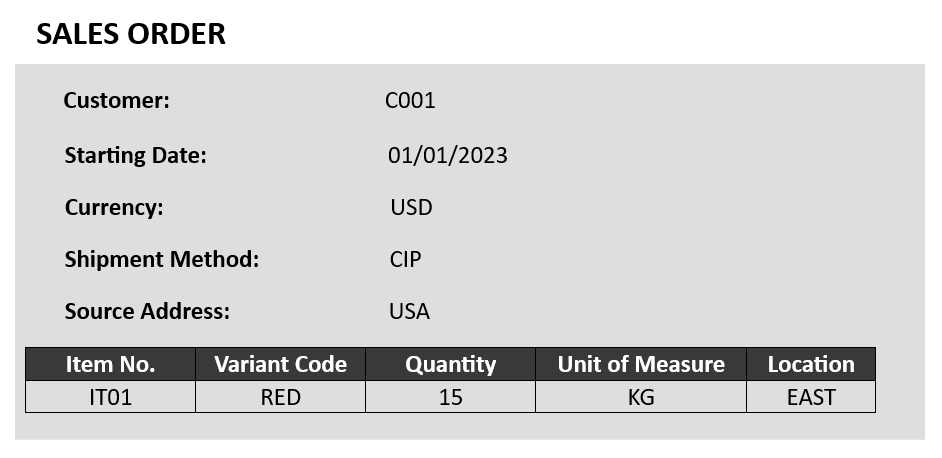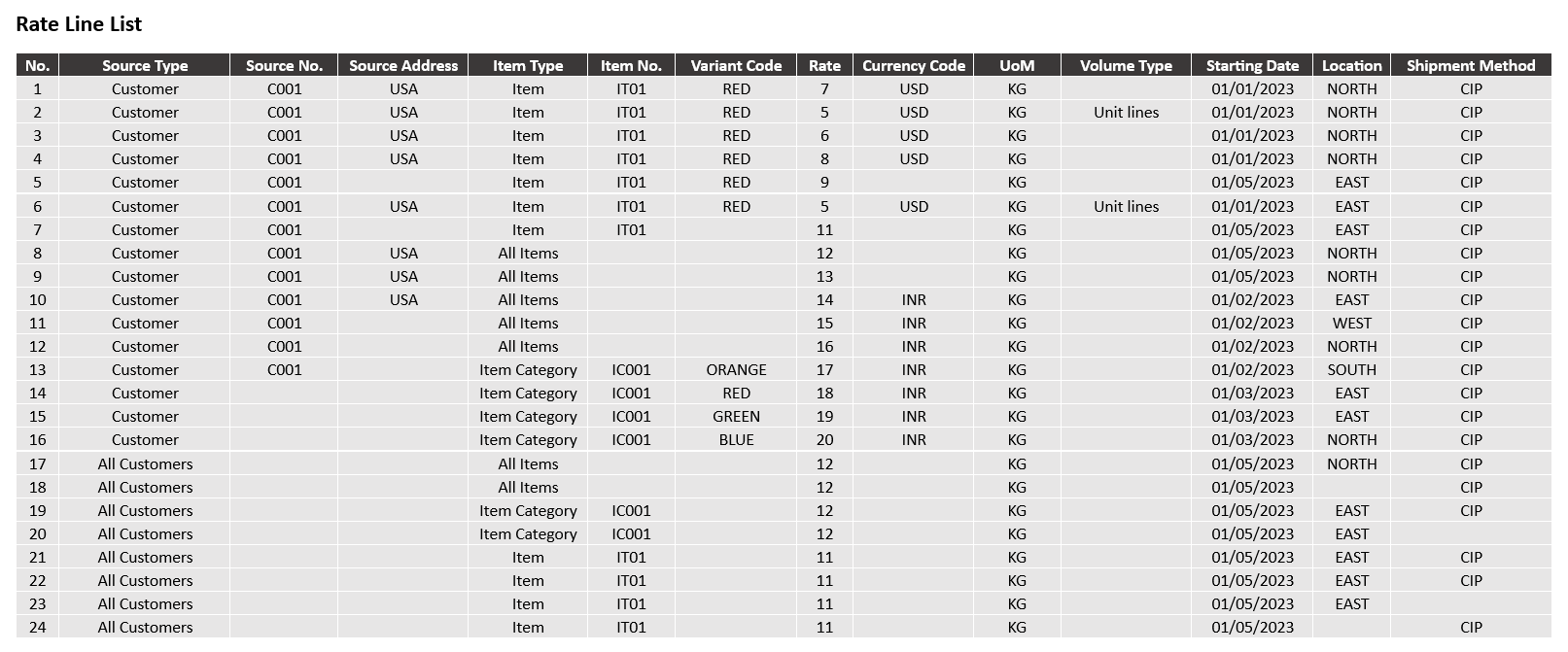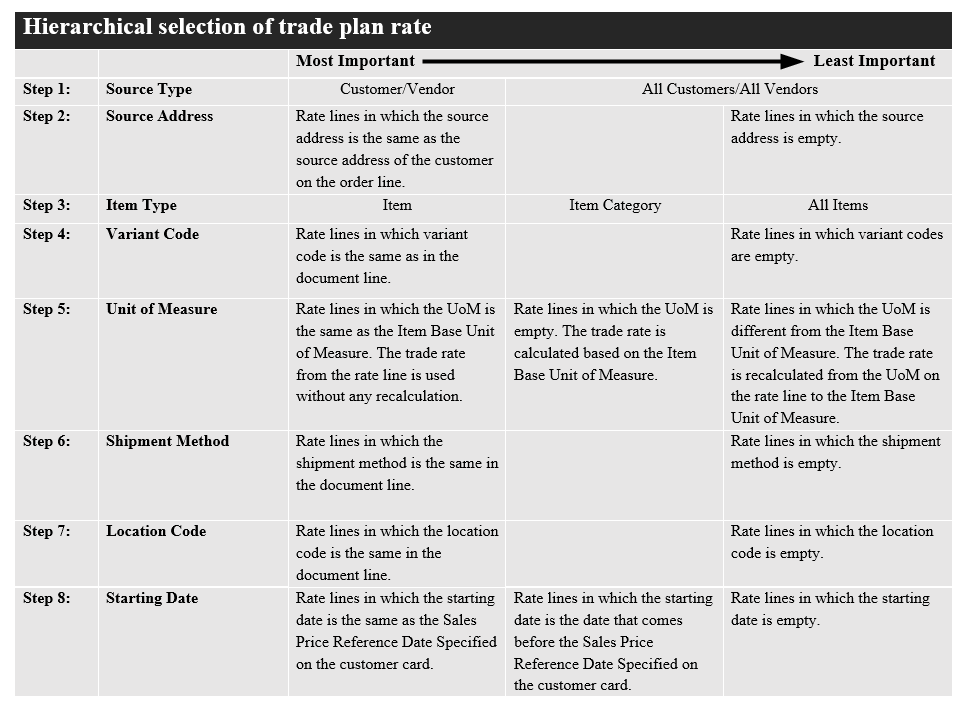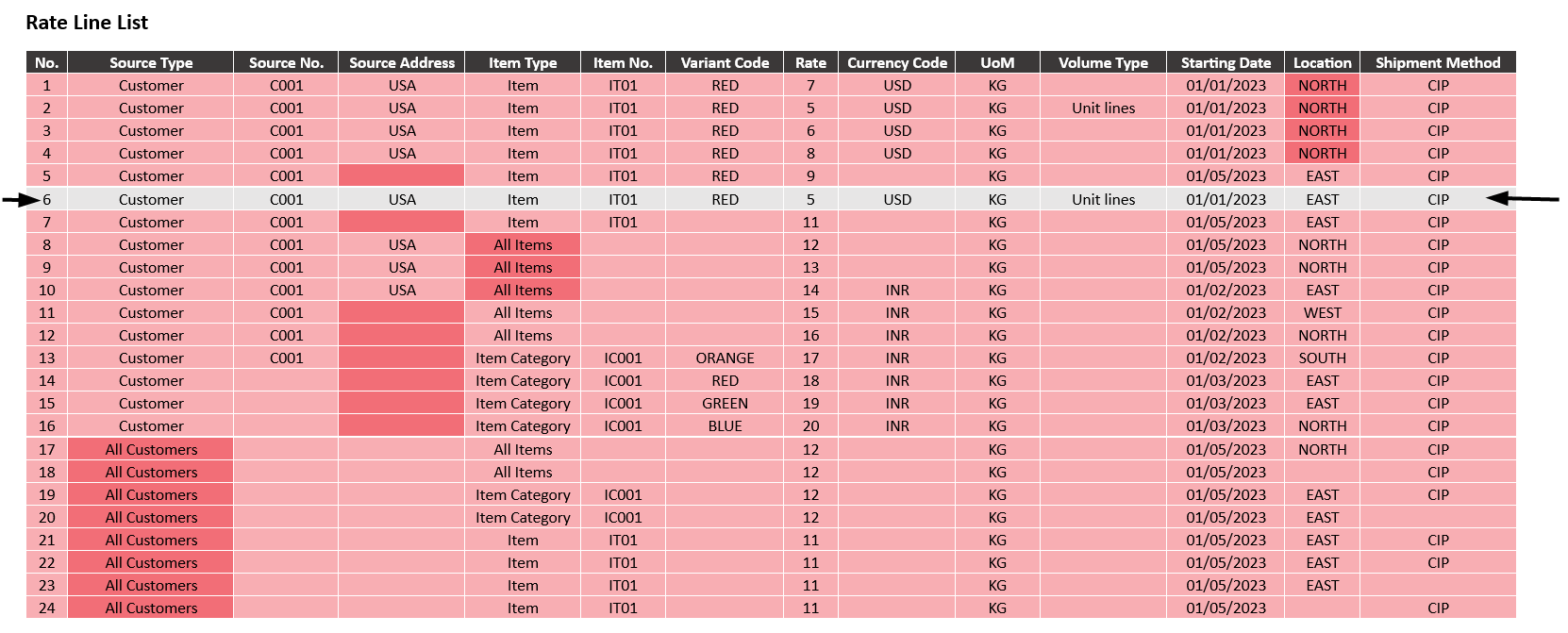Manage trade plan rate hierarchy
When you create a new sales order, the system automatically determines the trade plan rate to be applied. Here, we assume that the Trade Business Group and Trade Product Group fields are set to X and Y on the Trade Plan Groups, Customer Card, and Item Card pages.
To understand how a trade plan rate is selected for a sales order line, consider the following example. Let’s say you have created a sales order for customer C001, with a sales order line for item IT01:

The following rates for item IT01 exist on the Trade Plan Rates page. Please note that the rate lines that match the selected item number, customer, trade business group, and trade product group are displayed in this image. Any lines that do not meet these criteria have already been filtered out and are not shown in the image provided.

To determine which rate from the trade plan rates list will be selected for the order line, the system follows a filtering process. All trade plan rate lines that are not applicable to the current order (line) will be filtered out. To understand the criteria for determining which trade plan rate line is picked, please refer to the following information:
Source type
- Rate lines with Source Type set to Customer are only valid when the customer specified in the trade plan rate line is the same as the customer on the order.
- Rate lines with Source Type set to All Customers are always valid for all customers.
Source address
Only rate lines that have the same source address code as the customer on the order header or no source address code are valid.
Item type
- Rate lines with Item Type set to Item are only valid when the item specified in the trade plan rate line is the same as the item on the order line.
- Rate lines with Item Type set to Item Category are only valid when the item category specified in the trade plan rate line includes the item on the order line.
- Rate lines with Item Type set to All Items are always valid for all items.
Variant code
Only rate lines that have the same variant code as the item on the order line or have no variant code are valid.
Unit of measure
Rate lines that have any unit of measure code or have no unit of measure are valid. But the rate lines that have the same unit of measure as the base unit of measure for the item on the order line are considered first.
Based on the filtering process, the following scenarios determine how the trade rate is selected based on the unit of measure code:
- If only one rate line is filtered, and it shares the same unit of measure code as the base unit of measure code specified for the item on the order line, the trade rate from that rate line is used without any recalculation, using the Item Unit of Measure table.
- If only one rate line is filtered, and it has a different unit of measure code than the order line, the trade rate is recalculated from the unit of measure code on the rate line to the base unit of measure code specified for the item on the order line, using the Item Unit of Measure table.
- If only one rate line is filtered, but it does not have a unit of measure code specified, the trade rate is calculated based on the unit of measure code specified for the item on the order line, using the Item Unit of Measure table.
Shipment method
Only rate lines that have the same shipment method as the item on the order line or have no shipment method are valid.
Location
Only rate lines that have the same location code as the item on the order line or have no location code are valid.
Starting date
- For sales orders, only rate lines with no starting date or a starting date that is before or equal to the Sales Price Reference Date, specified on the customer card.
- For sales blanket orders, Sales quotes, and Sales Return Orders, only rate lines with no starting date or a starting date that is before or equal to the work date are valid.
- For sales invoices and sales credit memos, only rate lines with no starting date or a starting date that is before or equal to the posting date on the document line are valid.
- For purchase invoices and purchase credit memos, only rate lines with no starting date or a starting date that is before or equal to the posting date on the document line are valid. If the posting date is empty, then the work date is considered.
- For other documents, only rate lines with no starting date or a starting date that is before or equal to the order date are valid. If the order date is empty, then the work date is considered.
The following image explains the trade plan rate line filtering process, prioritizing certain fields and values in those fields from most important to least important. The system performs step-by-step checks, as mentioned in the image. The most important fields in this filtering process are Source Type, Source Address, and Item Type, which are evaluated in the first, second, and third steps to filter rate lines with the values mentioned as most important. Subsequently, the system proceeds to the fourth step, comparing the Variant Code field with the variant code on the order line. If a match is found, the system proceeds to the fourth step. In case the Variant Code is empty, the remaining trade plan rate lines (which passed the initial steps) are checked for values that are most important in the subsequent steps.
Lastly, if multiple lines still exist after examining all the steps, the system considers the trade plan rate line with the most recent starting date for further processing.
When no lines remain, trade rates will not be used on the order line.

Applying all the above steps to the valid rate lines we had in our example, would filter out the pink lines in the image below, resulting in 1 remaining (grey) price line.
Explanation:
Step 1: Since rate lines with the source type as Customer exist, 8 lines are filtered out.
Step 2: Since rate lines with the source address as USA exist, the rate lines with no source address are filtered out.
Step 3: Since rate lines with the item type as Item exist, 3 lines are filtered out.
Steps 4, 5, & 6: Since the remaining rate lines exist with the same variant code, unit of measure, and shipment method as the order line, the system moves further to the next step.
Step 7: Since rate lines with the location code as EAST exist, 4 lines are filtered out.
Implying the steps mentioned above, the pink lines in the following image are filtered out of the trade plan rate lines in our example. The reason why they are not valid (in combination with our order example) is highlighted in red.

The trade rate that will be used in the order line is 5 USD.